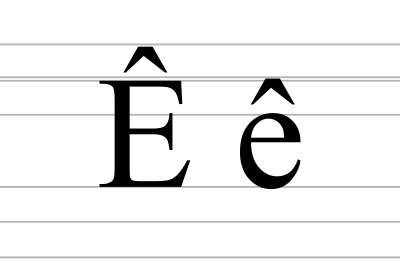
Search
Ê

Ê, ê (e-circumflex) is a letter of the Latin alphabet, found in Afrikaans, French, Friulian, Kurdish, Norwegian (Nynorsk), Portuguese, Vietnamese, and Welsh. It is used to transliterate Chinese, Persian, and Ukrainian.
Usage in various languages
Afrikaans
Ê is not considered a separate letter in Afrikaans but a variation of "E". The circumflex changes the pronunciation of "e" to be /ɛː/ (or /æː/ if the succeeding consonant is either a dorsal or a liquid)
Chinese
In the Pinyin romanization of Standard Mandarin Chinese, ê represents /ɛ/. It corresponds to Zhuyin ㄝ. The circumflex occurs only if ê is the only vowel in a syllable: ề /ɛ̂/ (诶; 誒; "eh!"). Without the circumflex, e as the only vowel represents /ɤ/: è /ɤ̂/ (饿; 餓; "hungry"). Elsewhere, /ɛ/ is written as a (after i or ü before n) or e (before or after another vowel), with the appropriate tone mark,: xiān /ɕi̯ɛ́n/ (先; "first"), xuǎn /ɕy̯ɛ̀n/ (选; 選; "to choose", noting that ü is written u after x), xué /ɕy̯ɛ̌ ~ ɕy̯ě/ (学; 學; "to learn"), xièxie /ɕi̯ɛ̂.ɕi̯ɛ ~ ɕi̯ê.ɕi̯e/ (谢谢; 謝謝; "thanks").
In Pe̍h-ōe-jī, ê is the fifth tone of e: ê (的; possessive, adjectival suffix).
French
Diacritics are not considered to be distinct letters of the French alphabet. In French, ê usually changes the pronunciation of e from /ə/ to /ɛ/. It is used instead of "è" for words that used to be written "es".
Friulian
Ê represents /eː/ and /ɛː/.
Khmer
Ê is used in UNGEGN romanization system for Khmer to represent /ae/ and /ɛː/, for example Khmêr (ខ្មែរ [kʰmae]) and Dângrêk Mountains (ដងរែក [ɗɑːŋrɛːk]).
Kurdish
Ê is the 7th letter of the Kurdish Kurmanji alphabet and represents /eː/.
Norwegian Nynorsk
In Nynorsk, ê is used to represent the reduction of the Old Norse sequence <eð>, similar to the use of ê for the historical sequence <es> in French. It is mostly used to differentiate words which otherwise would be spelled the same, e.g. vêr 'weather' and ver, imperative of 'to be'.
Persian
Ê is used in the Persian Latin (Rumi) alphabet, equivalent to ع.
Portuguese
In Portuguese, ê marks a stressed /e/ only in words whose stressed syllable is in an otherwise unpredictable location in the word: "pêssego" (peach). The letter, pronounced /e/, can also contrast with é, pronounced /ɛ/, as in pé (foot).
Tibetan
Ê is used in Tibetan pinyin to represent /e/, for example Gêrzê County.
Ukrainian
Ê is used in the ISO 9:1995 system of Ukrainian transliteration as the letter Є.
Vietnamese
Ê is the 9th letter of the Vietnamese alphabet and represents /e/. In Vietnamese phonology, diacritics can be added to form five forms to represent five tones of ê:
- Ề ề
- Ể ể
- Ễ ễ
- Ế ế
- Ệ ệ
Welsh
In Welsh, ê represents long stressed e [eː] if the vowel would otherwise be pronounced as short [ɛ]: llên [ɬeːn] "literature", as opposed to llen [ɬɛn] "curtain", or gêm [ɡeːm] "game", as opposed to gem [ɡɛm] "gem, jewel". That is useful for borrowed words with a final stress like apêl [apˈeːl] "appeal".
Other
In Popido, a fictitious dialect of Esperanto made by Manuel Halvelik for use in literature, ê represents /ə/. It is only used epenthetically to break consonant clusters, especially before grammatical suffixes.
Character mappings
Unicode encoded 5 pairs of precomposed characters (Ề / ề, Ể / ể, Ễ / ễ, Ế / ế, Ệ / ệ) for the five tones of ê in Vietnamese. Two pairs of the five (Ế / ế and Ề / ề) can also be used as the second and fourth tones of ê in Pinyin. The first and third tones of ê in Pinyin have to be represented by combining diacritical marks, like ê̄ (ê̄) and ê̌ (ê̌).
See also
- Circumflex
References
Text submitted to CC-BY-SA license. Source: Ê by Wikipedia (Historical)
Owlapps.net - since 2012 - Les chouettes applications du hibou



